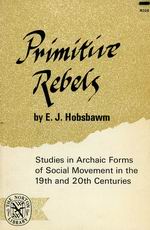
Primitive Rebels
Studies in Archaic Forms of Social Movement in the 19th and 20th Centuries
Hobsbawm, E. J.
Publisher: The Norton Library, New York, USA
Year First Published: 1959
Year Published: 1965
Pages: 202pp Resource Type: Book
Cx Number: CX7580
A study of 'primitive' or 'archaic' forms of social agitation.
Abstract:
This book expands on lectures given by E.J. Hobsbawm at the University of Manchester in 1956. The lectures are presented in a series of essays and include some topics that did not make it into the original presentation. The topics of these lectures are the early forms of social agitation. Such methods include slave revolts, banditry, secret societies, mob riots, peasant uprisings, and labour organizations. Hobsbawm looks at them in the context of the history and chronology of social activism.
There are nine essays included in this volume. After an introduction, Chapter 2 is called The Social Bandit and describes possibly the most primitive form of social protest: stealing from the rich. Chapter 3, Mafia, describes the secret sect in which different classes band together not only to defend society against threatening changes, but also to achieve the goals of the majority for the better. There are three chapters on Millenarianism, the hope for a radical change in the new millennium. Chapter 7, The City Mob, looks at primitive forms in modern society, such as organized action to achieve political change without a vision or ideology. The Labour Sects talks about the labour movement and its ties to socialism and radical thinking. Ritual in Social Movements analyzes the differences between modern and primitive methods, such as the use of form, symbolism, and ritual, which is far more common in primitive social movements. The lectures look at archaic protests, as well as modern movements that do not follow the traditional patterns of activism.
Throughout the book, Hobsbawm attempts to understand the people and places he is describing through personal contact. He claims that the issues cannot be fully understood without taking account of the lifestyles and political views of those involved. He talked to peasants, mayors, and movement leaders. The Appendix includes various documents that aim to help readers connect with those involved. These include letters, stories, interviews, court transcripts, and recorded conversations. The book offers not only a history of social movements, but also an understanding of the individuals who led them.
[Abstract by Mia Manns]
Table of Contents
Preface
1. Introduction
2. The Social Bandit
3. Mafia
4. Millenarianism I: Lazzaretti
5. MillenarianismII: The Andalusian Anarchists
6. MillenarianismIII: The Sicilian Fasci and Peasant Communism
7. The City Mob
8. The Labour Sects
9. Ritual in Social Movements
Appendix: In Their Own Voices
A letter from Pasquale Tanteddu, outlaw and bandit (Sardinia 1954)
The brigand Vardarelli helps the poor ( Apulia 1817)
A Bourbon brigand examined ( South Italy, early 1860's)
Donato Manduzio confutes a false apostle ( San Nicandro, early 1930's)
A peasant woman on the good society ( Piana dei Greci, Sicily1853)
A Commune unpoisoned by Cities (Ukraine 1918)
The peasant distrust governments (Ukraine 1917)
The Will of the Tsar (Poltava 1902; Chernigov 1905)
Conversation of Giovanni Lopez, cobbler (San Giovanni in Fiore1955)
Two strike sermons (Loray, North Carolina 1929)
A Lincolnshire unionist: Joseph Chapman (Alford 1899)
The 'Men of Decision' recommend a brother (Lecce, Apulia 1817)
Some secret oaths (Britain 1830's, Naples 1815-20, Paris 1834)
Index of Names
Subject Index
Subject Headings


